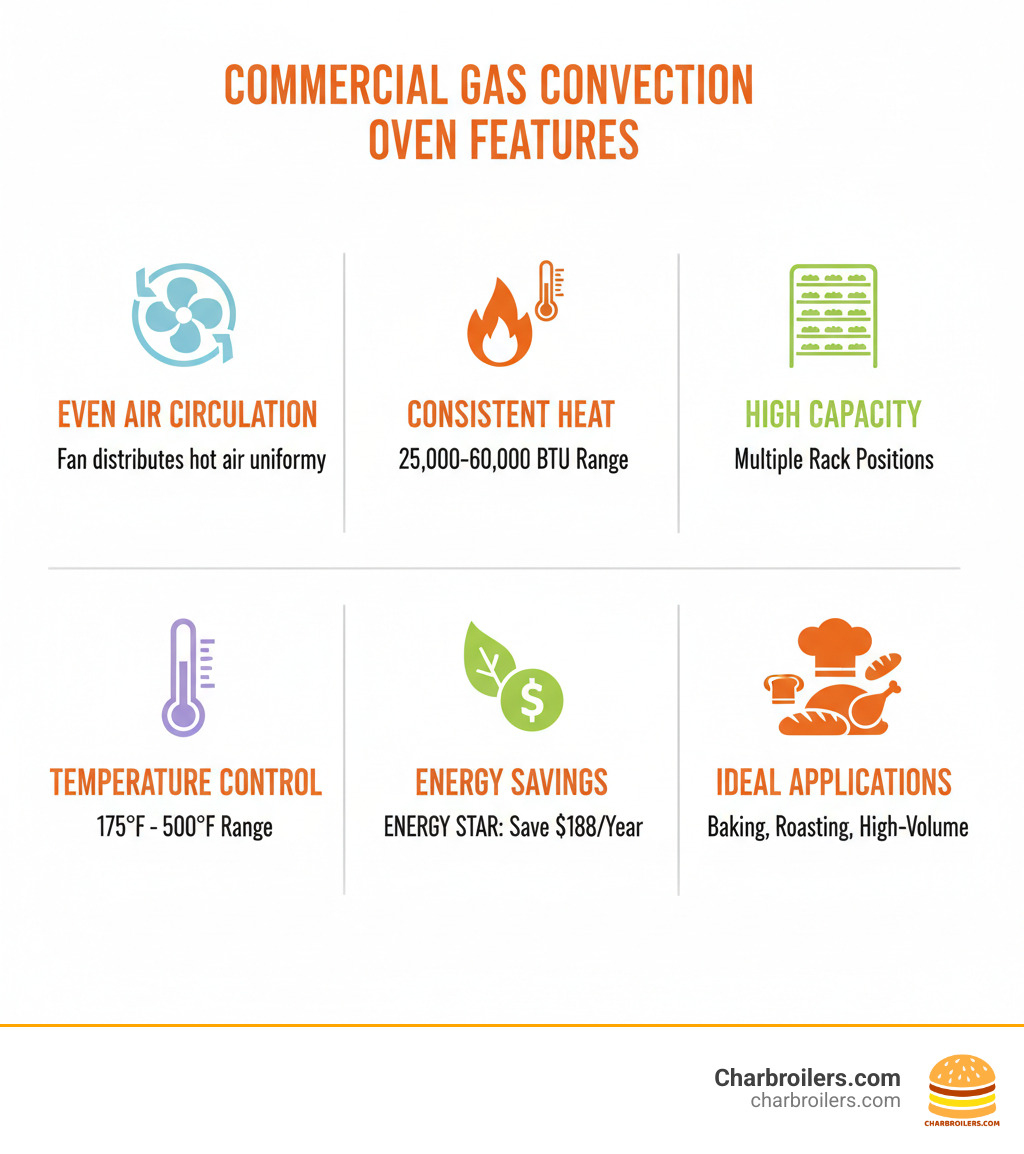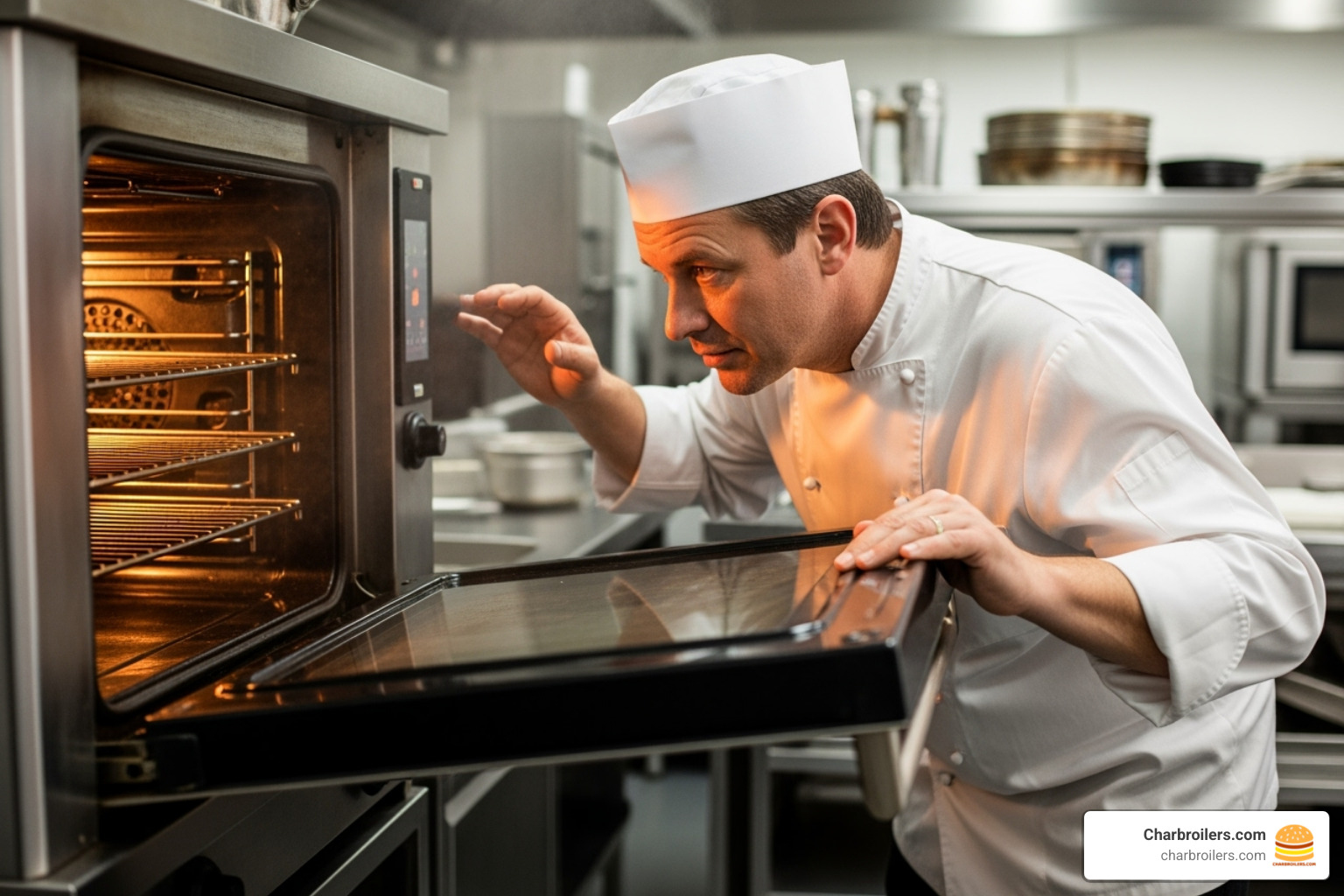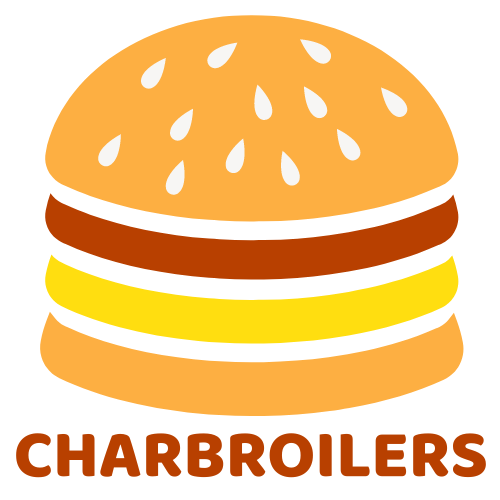
Top Commercial Gas Convection Ovens: Find Yours Today!
Share
Why Commercial Gas Convection Ovens Are Essential for Your Kitchen
A commercial gas convection oven offers faster cooking, consistent results, and cost-effective operation for busy kitchens. Here's what you need to know:
Key Benefits:
- Speed: Cooks up to 25% faster than conventional ovens with fan-forced hot air.
- Consistency: Even heat distribution ensures uniform cooking on every rack.
- Cost Savings: Natural gas is often cheaper than electricity; ENERGY STAR models save about $188 annually.
- Versatility: Handles everything from delicate pastries to high-heat roasting.
Popular Options:
- Full-size models: 5-rack capacity for high-volume kitchens.
- Half-size units: Space-saving solutions for smaller operations.
- Single vs. double deck: Choose based on production needs.
- BTU range: 25,000-60,000 BTU/hr depending on application.
For kitchens with a gas connection, this oven is an efficient, economical choice. Its fan circulates hot air, eliminating hot spots for perfectly browned, even results.
Natural gas convection ovens heat up faster than electric models and provide precise temperature control. For expanding bakeries, indirect-fired gas models are ideal due to lower fuel costs and suitability for large-scale production.
I'm Sean Kearney, founder of Charbroilers.com. With over a decade of experience, I've learned which features offer the best reliability, performance, and value in commercial gas convection ovens.

Commercial gas convection oven further reading:
- do commercial convection ovens need venting
- convection oven cleaning tips
- commercial electric range with convection oven
Why a Gas Convection Oven is a Kitchen Workhorse
In any busy kitchen, the commercial gas convection oven is a workhorse that proves its value daily.
Speed is where gas convection ovens really shine. They preheat faster than electric models, saving valuable minutes during busy services. Less waiting means more cooking and higher productivity.
The precise temperature control of gas ovens is something chefs appreciate. You can adjust heat instantly for delicate pastries or high-heat searing. The fan circulates air, ensuring consistent results on every rack without hot spots or the need to rotate pans.
Gas convection ovens are masters at browning and roasting. The circulating hot air creates even crusts on bread, caramelizes vegetables, and produces chicken with crispy skin. This process is faster than conventional ovens, allowing for lower cooking temperatures that help food retain moisture and natural juices—a difference your customers will notice.
The cost-effective operation of natural gas is a major benefit for high-volume kitchens. Lower fuel costs and faster cooking times reduce overall energy use, lowering utility bills and boosting productivity.
These ovens handle just about anything. Roasting, baking, broiling, reheating—a commercial gas convection oven is versatile enough for any menu, whether in a bakery, casual restaurant, or high-end steakhouse.
Want to get the most out of your fan-forced oven? Our guide on Blowing Hot Air: How to Properly Use Commercial Fan-Forced Ovens walks you through the techniques that'll help you achieve consistently excellent results.
How to Choose the Perfect Commercial Gas Convection Oven
Choosing the right commercial gas convection oven is crucial for your kitchen's daily operations. The right equipment can transform your workflow, while the wrong choice leads to frustration.

Start with sizing and capacity based on your volume. A small café might only need a compact half-size unit, while a high-volume restaurant requires a full-size, five-rack model.
Budget is a key factor. Prices range from around $2,000 for compact electric models to over $9,000 for a premium full-size commercial gas convection oven. Making the right choice upfront is a crucial investment. Leading brands earn their reputations through reliable performance, and comparing their unique features will help you find the best fit.
For a comprehensive breakdown of costs, check out our guide on Budgeting for Bake-Offs: How Much Does a Commercial Convection Oven Set You Back?
Natural Gas vs. LPG: Fueling Your Decision
Before looking at models, decide on your fuel source, as this affects installation and operating costs.
If you have a natural gas line, a natural gas convection oven is the most cost-effective choice. It provides a continuous, affordable fuel supply and excellent heat control, making it standard for most commercial kitchens.
Without a gas line, liquid propane (LPG) is a great alternative. It requires storage tanks and a delivery service but offers flexibility for food trucks, remote locations, or kitchens without gas infrastructure. Many models include an LP conversion kit, giving you options. Carefully weigh installation costs against long-term fuel savings.
Key Features of a Commercial Gas Convection Oven
These features make daily cooking easier and more consistent.
Capacity and size are determined by your production needs. Full-size models hold five standard 18" x 26" sheet pans for high-volume needs. Half-size units suit smaller operations or serve as backup ovens. Quarter-size models are available for tight spaces.
A double-deck configuration provides two ovens in one footprint, allowing simultaneous cooking at different temperatures. This is ideal for high-output kitchens. Single-deck ovens are sufficient for most medium-volume needs.
For controls, manual dials are simple and durable. Digital controls offer precision and programmable cycles for consistency. Premium models may have touchscreen interfaces for complex programs.
The door type affects workflow. Solid steel doors are durable and retain heat well but require opening to view food. Glass doors allow monitoring but need more cleaning. Some models offer removable doors for easy cleaning.
Rack configuration offers flexibility. Look for adjustable wire racks with multiple position guides to customize spacing for different foods.
If you're working with limited space, our guide on Maximize Your Space: Understanding Full-Size Commercial Countertop Convection Ovens can help.
Understanding BTU, Burners, and Cooking Performance
The power of a commercial gas convection oven is measured in BTUs (British Thermal Units), which indicates its heat generation and performance during peak hours.
BTU output ranges from 25,000 BTU/hr for smaller units to 60,000 BTU/hr for high-performance models. Double-deck ovens can double that output. Higher BTUs ensure faster heat recovery and consistent temperatures.
How the burner delivers heat also matters:
Direct-fired systems have burners inside the cooking chamber. The direct contact with flame creates intense, dry heat ideal for crisping foods like pizza, flatbreads, and cookies.
Indirect-fired systems have burners outside the chamber, with heat transferred via a heat exchanger. This provides gentle, consistent heat perfect for delicate items like cakes, pastries, and roasts that require even baking and moisture retention.
Your menu determines the best system. A pizzeria benefits from a direct-fired oven, while a bakery needs an indirect-fired model.
See how gas ranges can incorporate convection ovens in our article on Unlock Culinary Excellence: Exploring Commercial Gas Ranges with Convection Ovens.
Energy Efficiency and Long-Term Savings
Energy efficiency translates directly into monthly savings.
An ENERGY STAR certified commercial gas convection oven must have at least 49% cooking energy efficiency. This translates to about $188 in annual utility savings, or $1,884 over the oven's lifetime compared to a standard model.
By comparison, certified electric models are even more efficient but save less annually (around $94) due to higher electricity costs. The ENERGY STAR label always signifies lower operating costs.
While an ENERGY STAR model may have a higher upfront cost, the lifetime savings of nearly $2,000 make it a smart investment that also reduces your environmental impact.
We encourage you to learn more about ENERGY STAR certified ovens to understand the standards and find qualifying models.
Gas vs. Electric vs. Combi Ovens
Deciding between a commercial gas convection oven, an electric model, or a combi oven can be overwhelming. Let's break down the differences to help you choose.
| Feature | Commercial Gas Convection Oven | Commercial Electric Convection Oven | Combi Oven (Gas or Electric) |
|---|---|---|---|
| Performance | Faster heat-up, precise heat control, excellent for browning/roasting | Consistent, even heat, often higher energy efficiency for cooking, precise temperature control | Best versatility (convection, steam, combination), precise humidity control |
| Upfront Cost | Moderate to High | Often more affordable upfront | High |
| Operating Cost | Generally lower due to cheaper gas prices | Higher due to electricity cost, but can be more efficient in use | Moderate to High, depending on fuel and usage |
| Versatility | High (baking, roasting, re-thermalizing) | High (baking, roasting, re-thermalizing) | Extremely High (steaming, roasting, baking, re-thermalizing, sous vide) |
| Installation | Requires gas line and ventilation | Simpler (just plug in), may still need ventilation | Complex (water, drain, power, ventilation) |
| Maintenance | Regular gas line checks, burner cleaning | Electrical component checks | More complex (descaling, multiple component checks) |
A commercial gas convection oven excels in speed and economy. It heats up faster than electric models and has lower operating costs due to cheaper natural gas. Chefs also value its responsive heat control.
Electric convection ovens are a good choice without a gas line. They often have a lower upfront cost and simpler installation. They provide very consistent, even heat, which is ideal for baking, and can be highly energy-efficient despite higher electricity costs.
Combi ovens are the most versatile, acting as a convection oven, a steamer, or both. They can roast, steam, bake with steam injection, and even cook sous vide. However, they are significantly more expensive, require complex installation (water, drainage), and need more maintenance like descaling.
So which is right for you? For traditional baking and roasting with a gas line, a commercial gas convection oven offers great performance and value. Without gas, an electric model is a solid choice. For maximum versatility and a diverse menu, a combi oven's high cost may be justified.
For a deeper dive, our guide on The Ultimate Guide to Comparing Commercial Convection Ovens walks you through everything you need to know.
Installation, Maintenance, and Longevity
Proper installation and maintenance of your commercial gas convection oven are crucial for safety, efficiency, and protecting your investment.

A well-maintained commercial gas convection oven can last 10 years or more. Warranties typically range from one to five years. For example, a new Dukers DCCOG1 includes a 1-year parts and labor warranty. Certified used models may offer shorter warranties. The key to longevity is professional installation and consistent care.
Installation Checklist: Gas Lines and Ventilation
Installing a commercial gas convection oven is not a DIY job. It requires certified professionals to ensure safety and compliance with local building codes.
- Gas Line: The oven needs a dedicated gas line with the correct pressure for the fuel type (e.g., 4" WC for natural gas, 10" WC for propane). An installer will ensure the supply meets manufacturer specifications and local codes.
- Ventilation: Gas ovens produce heat, smoke, and grease that must be removed by a Type I hood installed over the unit, compliant with all local fire and building codes.
- Fire Suppression: Most kitchens require a fire suppression system (like an Ansul system) installed over cooking equipment.
- Clearances: Maintain adequate space around the oven, away from walls and combustible surfaces, as specified by the manufacturer to prevent fire hazards.
For a thorough understanding of ventilation, see our guide on Commercial Convection Ovens: Unpacking Venting and Hood Requirements.
Maintenance Best Practices for Your Commercial Gas Convection Oven
Regular maintenance extends your oven's life and ensures peak performance.
- Daily: Wipe the interior with a dry cloth to prevent buildup. Use a recommended degreaser for spills. Clean the exterior with warm, soapy water.
- Weekly: Perform a deep clean of the cavity, doors, and exterior using non-abrasive, commercial-grade cleaners. Clean the convection fan and baffle to prevent grease buildup.
- Regularly: Inspect and clean burners to ensure efficient gas flow. Ensure the convection fan spins freely; investigate any unusual noises immediately. Check door gaskets for damage and replace them if they are worn to prevent heat loss.
- Professionally: Schedule professional service annually or semi-annually. Call a technician immediately if you notice performance issues like irregular cook times, excessive noise, or higher fuel use.
Always follow your user manual and ensure all staff are trained on proper use and care.
Crucial Safety Features
Modern ovens have multiple layers of protection.
- Ignition & Flame Safety: Automatic pilot lights or electronic spark ignition provide safe lighting. A flame failure safety device is critical, cutting the gas supply if the flame goes out to prevent leaks.
- Operator Safety: Cool-touch doors prevent burns, while a door interlock switch can pause the fan and heat when the door is opened.
- Overheating Protection: An overheating safety cut-out automatically shuts off the oven if it detects unsafe temperatures.
- Certification: Always look for NSF and CUL/UL certification. These marks ensure the oven meets strict public health and safety standards for commercial use.
Frequently Asked Questions about Commercial Gas Convection Ovens
Here are answers to common questions from restaurant and bakery owners.
Which oven is best for commercial baking?
For bakeries, an indirect-fired commercial gas convection oven is a top choice. Gas is more cost-effective for all-day operation, and the indirect-fired design protects delicate baked goods from combustion gases by circulating only clean, hot air.
This gentle, consistent heat ensures even baking. Many models also offer steam injection, which is ideal for creating artisan breads with a crusty exterior and moist interior—the quality your customers expect.
What is the difference between a convection oven and a combi oven?
This is a common point of confusion. A commercial gas convection oven excels at circulating hot, dry air for baking, roasting, and re-thermalizing. It provides fast, even cooking with excellent browning.
A combi oven is more versatile, functioning as a convection oven, a steamer, or a combination of both. It allows for precise humidity control for a wider range of cooking techniques, including steaming and braising. The trade-off for a combi oven is a much higher price, more complex installation (requiring water and drainage), and more intensive maintenance.
If your menu focuses on traditional dry-heat cooking, a dedicated commercial gas convection oven offers excellent performance at a better price. For maximum versatility, a combi oven might be worth the investment. For more details, see The Ultimate Guide to Comparing Commercial Convection Ovens.
What is the typical lifespan of a commercial gas convection oven?
The typical lifespan of a commercial gas convection oven is about 10 years, but with proper maintenance, many last 15 years or more. Longevity depends on build quality, usage, and—most importantly—maintenance.
Consistent care is the most critical factor. Daily cleaning and regular professional servicing will dramatically extend the oven's life. New ovens typically come with a 1- to 5-year warranty covering parts and labor. Always check the specific terms for your chosen model.
Investing in quality equipment and committing to proper maintenance ensures your commercial gas convection oven will be a reliable partner for a decade or longer.
Find Your Perfect Oven and Fire Up Your Kitchen
Choosing the right commercial gas convection oven is about finding a reliable partner for your kitchen. It's an investment in creating great food while controlling operating costs.
A commercial gas convection oven combines speed, consistency, and economy. Its fan-forced air ensures even cooking, while quick preheating and lower natural gas costs save time and money. Whether you're baking pastries or roasting meats, the results are consistently perfect.
Not every oven fits every kitchen. Match the features—like size and deck configuration—to your specific volume, menu, and budget. A high-volume bakery has different needs than a small café, so choosing a full-size double-deck or a compact half-size unit makes a significant difference.
At Charbroilers.com, we help kitchens find equipment that delivers real value. We offer a wide selection at fair prices, with financing options for your business. Whether you're starting, upgrading, or expanding, we're here to help you make the right choice.
Use what you've learned to analyze your kitchen's needs. When you're ready, explore our selection to find the commercial gas convection oven that will become the hardworking heart of your kitchen. Your team will appreciate its reliability, your customers will taste the difference, and your bottom line will benefit from a smart investment.
For more insights, explore our complete guide to commercial charbroilers and other essential kitchen equipment. Here's to firing up your kitchen with confidence!
